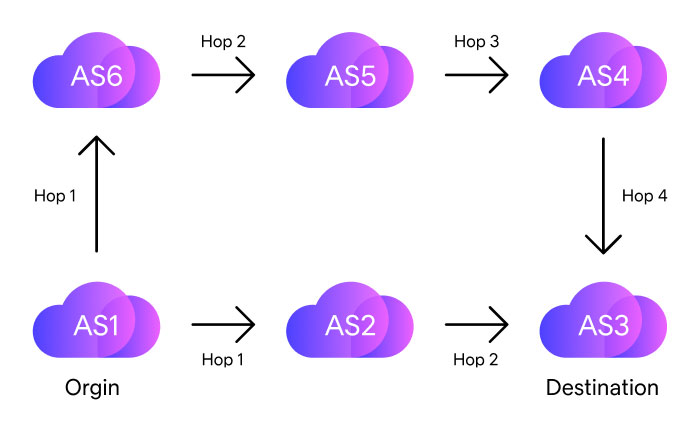Border Gateway Protocol (BGP) is effectively the universal navigation system of the Internet, a digital postal service that provides the necessary routing information for public Internet networks, or autonomous systems (AS) to steer traffic to each other. The primary challenge stems from the fact that, despite the Internet's appearance as a cohesive global network, it is fundamentally an interconnection of heterogeneous autonomous systems, each governed by distinct administrative policies and coordinated through standardized protocols such as BGP Without BGP, the Internet wouldn’t work.
Simply put, each AS is an administrative domain of one or several IP address blocks, also known as prefixes, and BGP is used by an AS to tell the rest of the Internet which addresses can be reached through that particular AS. It also provides other mechanisms to influence the way traffic is routed. Specific metrics can be applied, to control things like cost (for example, when prioritizing certain upstream transit providers) and load balancing. Filtering can also be implemented with BGP, providing AS network administrators with a powerful traffic engineering toolkit.
Border Gateway Protocol (BGP) is used to populate and maintain the global Internet routing table - a telephone book, if you like, for the Internet. This is essentially a route matrix that tells edge routers in a specific AS how to send traffic to a destination (IP address) outside the home network. From this, the best route can be established for traffic to take. Due to the vast number of networks connected, and the sheer number network prefixes involved, the global Internet routing table is very large and currently has more than 500,000 entries.
It is for this reason that the IP address information communicated is aggregated into blocks or prefixes, and the routing table is only updated when a network communicates a significant change in its logical structure - for example, when a new network block is added or removed.
The size and complexity of the Internet routing table means that powerful routing hardware, capable of processing a very large routing table, is a prerequisite for anyone running their own AS. Because the Internet is a common system, all route information must be available to all networks connected to it.
The following diagram illustrates, in very simple terms, the fundamental model of BGP and how it can be applied to manage routing across multiple paths:

If AS1 needs to route traffic to AS3, it has two different options:
In this over-simplified model, the choice is clear – routing via AS2 is the most efficient route, requiring fewer hops than the longer path via AS6. In reality route selection is made using complex algorithms and there are other factors that come into play, including the aforementioned BGP metrics and overriding business considerations. BGP is fundamentally a very trusting protocol and unable to verify the validity of route updates. This makes it susceptible to malicious interference. However, a mechanism known as RPKI is increasingly being used to increase the security of BGP updates and reduce the risk of outages and unauthorized manipulation.
A BGP community is essentially a metadata tag attached to a BGP route. While it doesn't alter the route itself, it provides policy-based instructions to other routers on how that route should be handled. As the world’s leading Internet backbone provider, AS1299 bears a critical responsibility to uphold a stable and resilient global routing environment—not only for directly connected networks, but for the broader Internet ecosystem. Our BGP community attributes empower both customers and peers to exert granular control over upstream routing policies and to optimize traffic engineering across diverse network paths.
Owning and operating an AS is a significant administrative and operational undertaking that is usually beneficial for businesses with larger networks and significant traffic volumes. For those that do, there are a number of benefits:
For smaller networks, or those not wanting to take on the additional responsibility of AS ownership, DIA services are compelling alternatives.
The Border Gateway Protocol (BGP) is essential for maintaining the global Internet routing table, enabling Autonomous Systems (AS) to communicate routing information effectively. It ensures data packets are directed to their correct destinations by determining the best paths based on various metrics, such as cost and load balancing. BGP also provides mechanisms for traffic engineering and route filtering, enhancing network stability and efficiency.
BGP manages the complexity of the Internet's routing table, which contains over 500,000 entries, by aggregating IP address information into blocks or prefixes. This helps reduce the size of the routing table updates, which are only made when significant changes occur, such as the addition or removal of network blocks. This aggregation allows for efficient routing and helps maintain the performance of the global Internet infrastructure.
BGP is a fundamentally trusting protocol, making it vulnerable to malicious interference, such as route hijacking. To address these security challenges, mechanisms like Resource Public Key Infrastructure (RPKI) are increasingly used. RPKI helps validate the authenticity of BGP route updates, reducing the risk of unauthorized manipulation and enhancing the overall security and stability of Internet routing.